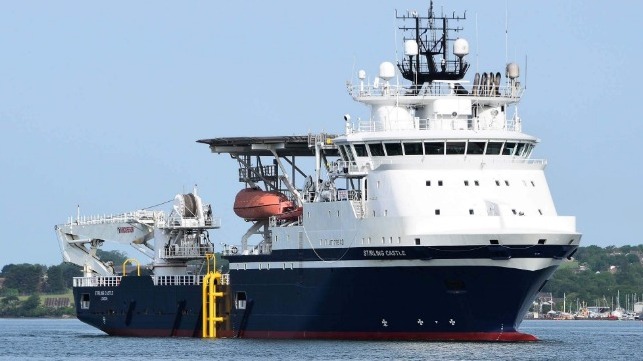Royal Navy Completes Conversion of PSV into Minehunting Mother Ship

Four months after taking delivery on a commercial offshore service vessel used in the oil and gas and wind sectors, the Royal Navy rolled out its newest ship RFA Sterling Castle. Making her way down the Hamoaze at Plymouth, the repurposed vessel is beginning trials and training to become a new concept in minehunting and part of Prime Minister Rishi Sunak’s effort to enhance the defense of the UK’s offshore assets.
Completed just a decade ago by Vard, the vessel was serving as a platform supply vessel in her prior life known as the Island Crown. She measures 317 feet in length and as built had accommodations for 100 as well as a large open cargo and deck space. Acquired for a reported $50 million, the Royal Navy said it had looked carefully at the commercial S&P market to find the right vessel for the role. As a result, the focus on the conversion was the installation of military communication systems and other items to support RFA operations.
“Getting underway with crew for the first time is a significant milestone in RFA Stirling Castle’s transition into service,” said Captain Ali Clack, Stirling Castle’s first Commanding Officer. He emphasized that the next few months the focus is on learning how best to run and maintain the distinctive-looking 6,000-tonne vessel, test safety systems, and effectively write the instruction/operators’ manual.
She will now undergo trials and training as the few dozen crew learn how she handles and how to safely operate both the systems originally installed and some of the specific equipment fitted since she sailed into Plymouth in January.
When operational, the Royal Navy highlights that the ship will host various autonomous minehunting systems, operated by personnel who will launch and recover the devices, as well as analyze the data they gather while scouring home waters for mines and underwater explosive devices. Stirling Castle will replace traditional mine countermeasures vessels, instead exploiting a series of uncrewed devices to locate, identify and neutralize mine threats, particularly in UK waters.
The Royal Navy says the aim is to both search more extensive stretches of sea and remove the threat to naval personnel by keeping them well away from the minefield. This approach employs robotic systems to do the legwork.
She joins RFA Proteus, a second oil rig support vessel also acquired by the Royal Navy to enhance surveillance and security efforts for critical seabed telecommunications cables and oil and gas pipelines. Having started her life as the Topaz Tangaroa, the vessel is completing her overhaul and commissioning at the Cammell Laird yard in Birkenhead. She is becoming the UK’s first ship dedicated to the safeguarding role and is aptly being called a Multi-Role Ocean Surveillance vessel. Also due to depart the shipyard in the coming weeks, she will be crewed by around two dozen RFA sailors, plus 60 or so Royal Navy specialists operating autonomous systems and over underwater surveillance kit. The RFA highlights that this is an entirely new mission and it believes the PSVs with the strong seakeeping capabilities are well suited for these new roles.
